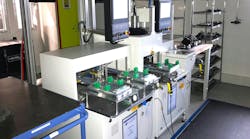By J.R. Wilson
MURRAY HILL, N.J. — Scientists from the Bell Labs segment of Lucent Technologies in Murray Hill, N.J., are reporting creation of a new class of single-molecule organic transistors that are less than one-tenth the size of any transistor previously demonstrated.
"The molecular-scale transistors we have developed may very well serve as the historical 'bookend' to the transistor legacy started by Bell Labs in 1947," says Federico Capasso, Bell Labs vice president for physical research.
The size of a transistor's channel — the space between its electrodes — influences output current and switching speed. At a size described as one million times smaller than a grain of sand, these new transistors have a channel length of only one molecule. While still in prototype, the new high-speed carbon-based electronics eventually could mean putting thousands of times as many transistors onto each chip than is possible today.
The successful effort by Bell Labs scientists Hendrik Schon, Zhenan Bao, and Hong Meng in fabricating molecular-scale transistors that rival conventional silicon transistors in performance uses a class of organic semiconductor material known as thiols.
"When we tested them, they behaved extremely well as both amplifiers and switches," says experimental physicist Schon, the lead researcher.
Using the tiny transistors, the team built a voltage inverter — a standard electronic circuit module commonly used in computer chips — that converts a "0" to a "1" and vice versa. They used a self-assembly technique and a design in which each electrode is shared by many transistors to overcome challenges in fabricating electrodes separated by only a few molecules and attaching electrical contacts to them.
"We solved the contact problem by letting one layer of organic molecules self-assemble on one electrode first and then placing the second electrode above it," says Bao, an organic chemist. "For the self assembly, we simply make a solution of the organic semiconductor, pour it on the base, and the molecules do the work of finding the electrodes and attaching themselves."
The chemical self-assembly technique, while relatively inexpensive, is key to reducing the transistor's channel length. In the experimental transistors, that channel is between one and two nanometers (billionths of a meter), an order of magnitude smaller than any previous transistor channel.
"What was unique about it was making a new design of the device that allowed us to control the critical dimension by the length of the molecule and not by lithography," Schon says. "Therefore we are not limited by conventional lithography; we can just synthesize molecules of different lengths and they can define the channel length and make the devices much smaller."


